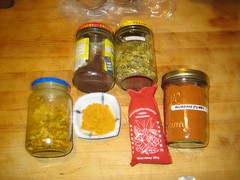It's a Spicy World
Most people go to foreign countries to see the Capital Letters: the Famous Church, the Spectacular Ruins, the Theater, the Opera. Plotnik goes for the food.
Look at the above photo. In the top row, there is sumac from the Spice Bazaar in Istanbul and huacatay from the Central Market in Cuzco. In the bottom row, rice seasoning mix from Victoria Market in Durban, a very pungent turmeric from Cuzco, a red bag of blisteringly hot paprika from Budapest, and a bottle of Mother-in-Law-Killer curry mix from Johannesburg. Not in the picture are the pepines chiles from Jalapa, the biryani seasoning from Singapore, the oregano from the Turkish village (that turned out to be lemon balm), the red peppercorns (that were too wet to grind and rotted before they dried), all the other weird, nameless stuff...and the chuño.
Chuño is a staple of the high Andes, where the potato originated. The Quechua-speaking people who live there developed more than 1,000 varieties of potatoes. Little ones, big ones, green ones, red ones, blue ones, skinny ones, fat ones. Without Peru there would be absolutely nothing to eat in Ireland except beer.
But it's freezing at 15,000 feet during the long winter, so the people had to come up with a way to preserve their potatoes.
What they do now is what they have done for millennia. They harvest their potatoes, then leave them outside overnight so they freeze, In the morning, when the potatoes thaw out, the people cover them with hay and stomp on them to get out all the moisture, and then leave them out to freeze again. After a week or so of freezing, thawing and stomping, what is left of a large potato is a little white ball. These are called chuño, and they will last for years, maybe centuries, maybe 'til Judgement Day, maybe longer, because nobody in their right mind would eat them.
Not that The Great Plotnik wouldn't try. He hung out a lot in the Central Market in Cuzco. It was a giant warehouse, covered by a tin roof, outside of which was said to be a paradise for pickpockets lurking on the very thin, 18" wide sidewalks.
Inside, you could buy alpaca skins, porcupine needles, fresh combinations of juices made from tropical fruits, fifty different kinds of potatoes, herbs to cook with, herbs to cast a spell with, woven blankets and sweaters, soccer balls, avocadoes the size of softballs...and barrel after barrel of chuño.
As is always the case in every foreign country, when the local women discovered the American wanted to cook their specialty, they insisted on gathering around to titter. When they were done tittering it was time to give Plotnik instructions.
Several sturdy women in red sweaters, blue ankle length skirts and derby hats, speaking a beautifully accented Spanish, told Plotnik what to do. First, soak the chuño for 24 hours, and then boil it a few hours, adding fresh huacatay and a few onions. That's all there is to it.
After the women finished explaining something in Spanish, they'd say something else to each other in Quechua, which would make them all laugh. Not a good sign? No.
So, when Plotnik got back to Saint Plotniko he soaked his chuño 24 hours. When he removed them from the water they seemed exactly the same as when he put them in. He put them on the stove in a gallon of water, added a handful of huacatay. After three hours he checked the chuño and they hadn't changed. Two hours later they hadn't softened any either, and three hours after that they felt exactly the same as when he bought them at the Central Market. He could hear the women tittering and belly laughing in Quechua.
Undeterred, he served the chuno in a broth. Disinterested in his story, Ducknik refused to touch them. Potato soup, it wasn't. Water with petrified rocks, it was. The whole thing went in the garbage.
Traveling is so cool.



1 Comments:
And you wonder why those women never had any teeth.
Post a Comment
<< Home